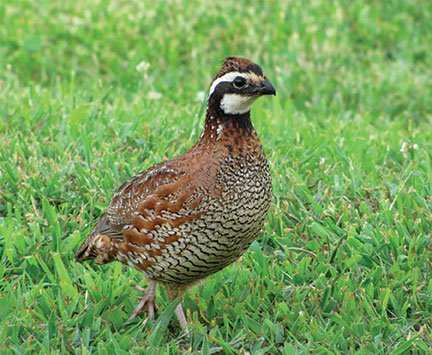By Mark Beason
With the sun making its final decent in the west, a gentle breeze in the east has the tops of the broom straw swaying in rhythm. Just ahead of Chris Walker is Pete, a bird dog deluxe, on point and his striking pose looks as if came out a Nash Buckingham story. Pete is doing what he was born and trained to do – point quail.
Quail hunting conjures up images of a true gentleman’s sport and at one point it was the primary game of choice for sportsmen. Once abundant throughout the Southeastern United States, quail numbers have been diminishing for decades. While there are many theories on the population decline the main culprit is habitat loss.
“There’s not one thing you can point your finger at and say that’s what caused the consistent drop in wild quail numbers,” said Adam Butler, a wildlife biologist with the Mississippi Department of Wildlife, Fisheries, and Parks and an avid quail hunter. “But the underlying factor is going to habitat loss. While it’s not the only reason it’s certainly a significant part of the equation.”
Butler is a part of a small group of people that still actively pursuit wild birds. For those continuing this tradition it’s more than just hunting birds, it’s a deeply rooted passion for keeping the tradition alive.
“It’s certainly not easy and you have to be willing to work at it and put in the time,” Butler said. “But all those hours walking and working your dog pay off when you find a covey and get that adrenaline going. It’s really hard to describe.”
With habitat being a primary focus, most of Butler’s trips are on public land. Habitat management on public land is more intense and the result is better opportunities for quail reproduction. Wildlife biologists use things like prescribed fire as a critical tool in habitat management for multiple species and quail are a byproduct.
While landowners want to have quail on their property, having them in huntable numbers can be a significant challenge. Butler actively works with landowners on a variety of management plans and most will mention quail.
“Whether they quail hunt or not most landowners have a soft spot for quail and truly want to have them on their property,” Butler said. “Having a covey or two behind the camp so you can hear them in the evening isn’t difficult to achieve. Now, if you want a truly huntable population then that can pose a number of challenges.”
For private landowners the most significant challenge is having a large enough track of land and the willingness to manage it intensely for quail. This is the reason most quail hunters spend their time on public lands. In Mississippi, large tracks of public lands are available statewide and open to public hunting. This makes them attractive to serious quail hunters looking to flush wild birds.
Walker spends nearly all this time on public hunting land, and he says the key educating yourself on the habitat on each property.
“The maps on the WMAs (wildlife management areas) are really good and if you take the time to plan your hunt you can have a reasonable amount of success,” Walker said. “But if you are expecting point on covey every couple hundred yards then your expectations aren’t going to meet reality.”
For hunters like Butler and Walker they utilize another resource when working their dogs in the field. While getting on covey’s quail can be difficult at times finding woodcock provides another avenue. This upland bird can be found throughout the Southeast region and provides another opportunity to work your bird dog. While some quail hunting purist scoff at the idea of woodcock, it’s a fun and much needed alternative for many.
“I really don’t hunt pen-raised quail, so it can be very difficult at times to get work in with my dogs on wild birds,” Butler said. “I really like hunting woodcock and they are a lot of fun to hunt. While it may not be traditional for some, it’s something you need to consider if you are strictly going after wild birds.”
As the sun finally sets on Walker’s bird hunt, he rewards his dog for a job well done. While the glory days when the bobwhite quail were plentiful may very well have fallen like the setting sun, there are still miles to walk, stories to tell, and memories to make for the upland bird hunter.



